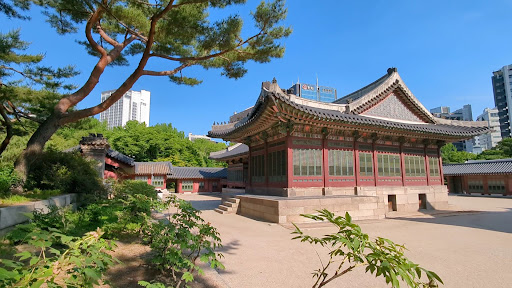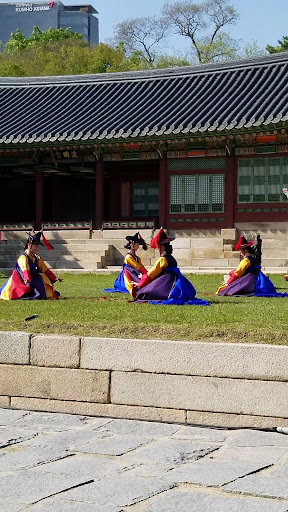Deoksugung Palace: Where Humble Beginnings Lead to Royal Grandeur
TLDR: Deoksugung Palace offers a captivating blend of Korean history and diverse architecture, from its unassuming entrance to its grand halls and Western influences. It's a unique and worthwhile exploration of Seoul's royal heritage.
Standing before Daehanmun (大漢門), the main gate to Deoksugung Palace, it's easy to imagine the city's pulse shifting around this once less prominent gate. There's a sense of quiet resilience in its facade, hinting at the stories within.
Royal Palace Pass: Snagging the Royal Palace Pass for just KRW 6,000 felt like unlocking a secret treasure map to Seoul's royal heritage. Five incredible sites for less than the price of two individual tickets? Yes, please!
Royal Guard Changing Ceremony: The rhythmic beat of the drums and the vibrant colors of the Joseon Dynasty uniforms bring history to life right before your eyes at the Royal Guard Changing Ceremony. It's a captivating 20-30 minute spectacle that truly transports you back in time.
Junghwajeon (中和殿): Walking into the courtyard of Junghwajeon, the undisputed heart of Deoksugung Palace, you can't help but be amazed by its majestic presence. The intricate details of the roof seem to whisper tales of royal ceremonies and the weight of history held within its walls. Imagine the dignitaries who once stood on those very rank stones This building truly stands out as the palace's most beautiful structure.
Seokjojeon stands in stark yet harmonious contrast to the traditional architecture, a stately Neo-Renaissance building that speaks of a fascinating period of cultural exchange. The Western-style garden and fountain offer a moment of unexpected European elegance.
Seokjojeon: Then, a delightful surprise! Seokjojeon stands in stark yet harmonious contrast to the traditional architecture, a stately Neo-Renaissance building that speaks of a fascinating period of cultural exchange. The Western-style garden and fountain offer a moment of unexpected European elegance.
Jeonggwanheon (靜觀軒). This pavilion elegantly blends Eastern and Western design elements and once served as the esteemed home for royal portraits of the Joseon dynasty. Its unique character is a testament to the palace's diverse history.
Deokhongjeon (德弘殿) : For a truly serene and visually stunning experience, seek out Deokhongjeon (德弘殿). Built relatively recently in 1911, this hall exudes a harmonious and majestic aura from every angle. Its refined architecture and artistic details make it arguably the most photogenic spot within Deoksugung Palace. Perhaps the best part? You might just find yourself enjoying its beauty in relative tranquility, away from the crowds.
Gwangmyeongmun Gate: This wasn't just any entrance, it was the main gate leading directly to Hamnyeongjeon, the sleeping quarters of King Gojong, the last king of Joseon and the first emperor of the Korean Empire.
Don't just breeze through Deoksugung - take your time, wander through its diverse structures, and let the stories of its past unfold before you. It's a unique perspective on Seoul's royal heritage that's well...
Read moreDeoksugung is one of the Five Grand Palaces of the Joseon Dynasty, located next to Seoul Plaza and City Hall in the city centre. Note the palace is closed on Mondays.
This palace served as the residence of the Royal family twice, during late 16th century and then again at the turn of the 20th century, providing well preserved buildings of traditional Korean and Western architecture.
Here you will find a collection of traditional Korean style entrance gates, lovely inner courtyards, worship and residential halls, pavilions and landscaping, all quite similar to what you see at the much larger Gyeongbokgung and Changdeokgung Palaces. You can also watch Changing of the Guards ceremonies here at Daehanmun Gate.
Two unique inclusions at Deoksugung include the Western style buildings at Seogeodong Hall, which was built in European style in 1910, and the adjacent building used to house the Museum of Modern and Contemporary Art (MMCA) - Deoksugung branch.
One of the things we very much enjoyed about visiting Deoksugung during the autumn was the fantastic fall foliage display seen throughout the palace grounds. There were numerous spots where we found multiple colours of tree leaves that made for lovely photographs. The autumn scene here was considerably more impressive here than at other palace grounds visited during this trip to Seoul.
We were however, disappointed to find the MMCA Deoksugung Art Museum closed during the time of our visit. There was no indicated closing on the MMCA or Deoksugung websites nor at the place entrance, which was odd.
Overall, we quite enjoyed spending time at the Deoksugung Palace. Not only was it exceptionally beautiful this time of year, but, we found it more management a place to visit compared to larger palace grounds around Seoul. You can comfortably browse Deoksugung in 30-45 minutes or longer if you want to visit more leisurely. This is a very good and cheap attraction visit to consider making during...
Read moreIf you are interested in the history of Korea and specifically the Chosen Dynasty, this is a must see palace in the central area of Seoul. What is really unique about this location is the mixture of classic Chosen Architecture and elegant western architecture that has features that harken back to the Roman Empire. They were built in six months at a time when Korea became an empire. But is was short lived as the same year that these buildings were built, the country was annexed by Japan and became a part of the Japanese Empire. This is the great irony exhibited and you must think of is as you look at the beautiful Chosen buildings where the King of Korea resided and the buildings built as the Empire of Korea became a Vassal state of Japan. This position lasted until 1945 when Japan was defeated in World War 11.
The grounds have a a number of explanation placards that are written in Korean and English Language. Be aware that the museums at the location are closed on Sunday and you must make reservations one week before to enter the buildings built in 1910. Making reservations is well worth the effort as there is much to see in these buildings as the displays help one to gain a better understanding of the dynamics of the period when they were built.
So if you are visiting Seoul, definitely visit this palace. It is definitely a must see location. There are also guided tours of the location with very knowledgable Korea guides who speak excellent English and other...
Read more


